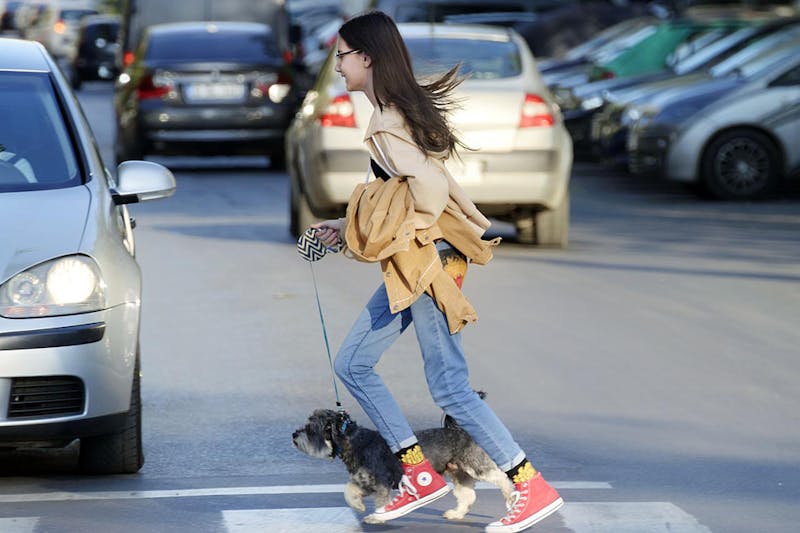
There are many rules of the road that drivers and pedestrians must follow to ensure the safety of everyone. One question that often comes up is when a driver must yield to a pedestrian.
Many people think that drivers must always yield to pedestrians, but this is not the case.
The information that follows will give you a brief overview of instances in which drivers must give right-of-way to pedestrians and when pedestrians must wait for traffic before continuing to walk instead. We will also address the role a lawyer plays in your case if a motorist strikes and hurts you.
Do Pedestrians Always Have the Right of Way?
Arkansas law, AR Code §27-52-1201, refers to many instances in which motorists and pedestrians must yield to each other’s rights of way.
Some instances in which motorists must yield to a pedestrian in Arkansas include when:
- Pedestrians are crossing at a traffic signal-controlled intersection on green, and there’s a “go” indicator illuminated
- Motorists cross sidewalks when entering or departing parking lots, alleys, or driveways
- Pedestrians are standing or walking inside of marked crosswalks that aren’t controlled by traffic signals
Even though there are laws in place regulating pedestrian and driver right-of-way situations, these statutes leave very little room for error. Pedestrians and drivers must behave predictably and carefully to avoid accidents. A simple mistake can result in a collision.
There are several instances in which drivers should have the right of way yielded to them by pedestrians. However, some exceptions to the rule may include certain situations in which select pedestrians enter into their purview, including when a pedestrian is:
- Already crossing at a marked or unmarked crosswalk
- Crossing at an intersection with a stop sign or red light and a driver is turning
- In a designated crosswalk for school children
- Crossing in a parking lot
- Using a white cane or guide dog
As you can see, there are many instances where drivers must be aware of pedestrians and yield to their right of way. However, there are also several instances where pedestrians must allow traffic to continue even if they believe they possess the right of way themselves.
When Must Pedestrians Yield to Drivers?
Pedestrians do not have the luxury of the protection of the shell of a vehicle when involved in accidents. Because of this, pedestrians need to know when they must yield the right of way to drivers.
There are several instances where pedestrians must yield the right of way to drivers. These instances include, but are not limited to when:
- A driver is already in an intersection
- A driver is approaching an intersection and has the right of way
- A pedestrian is crossing outside of a crosswalk
- A pedestrian is crossing against a red hand signal or “do not walk” sign
- A pedestrian is jaywalking
Pedestrians crossing outside of a crosswalk or traffic light must take extreme caution. If a driver is already in the intersection, the pedestrian must yield to the motorist. If a driver is approaching an intersection and has the right of way, the pedestrian must yield in this instance.
Pedestrians need to be aware of their surroundings; they should never cross outside of a crosswalk or against a red hand signal. Doing so puts them at risk of getting struck, and it is illegal. Likewise, stepping off a curb suddenly at a crosswalk when a driver isn’t expecting it or when in close proximity to them can also result in an accident.
Jaywalking is defined as crossing a street away from a crosswalk or intersection. It’s both illegal and extremely dangerous. Jaywalking should be avoided at all costs. Both drivers and pedestrians should do everything to avoid a collision as there is no such thing as a minor pedestrian accident. For instance, a staggering 6,205 pedestrians lost their lives here in Arkansas during the most recently reported year (2019).
What Happens When There Is a Pedestrian Accident?
Unfortunately, the worst has occurred, and a pedestrian was involved in a collision with a driver. Who is at fault? It depends on the situation. If the pedestrian was crossing outside of a crosswalk or on a red hand signal, the pedestrian would likely be at fault. If the driver was speeding, not paying attention, or under the influence of drugs or alcohol, the vehicle’s operator would likely be at fault.
If you are ever involved in an accident as a pedestrian, the best thing to do is to stay calm and call the police. The police will come to the accident scene and gather all of the necessary information. They will then be able to determine who is at fault.
If you are involved in an accident as a pedestrian, the first thing you should do is seek medical attention to get checked out. You may learn that you’ve suffered an injury as serious as the following in the crash:
- Bone fractures requiring amputation
- A spinal cord injury
- Blunt force trauma to your head or torso
- Internal organ damage or bleeding
You should then consult with a lawyer soon thereafter.
How To Move Forward After a Pedestrian Crash
It can be a bit much dealing with pesky insurance adjuster calls and managing all your doctors’ appointments while you still have your typical obligations to tend to. This is where an attorney can provide assistance. These aren’t the only things that they can help with, though. Having an attorney working on your case sends a message to insurers that you mean business.
We at McMath Woods P.A. can help you get the compensation that you deserve so that you can receive the best medical care possible and recover your other accident-related expenses. All you need to do is initiate contact with us for us to begin reviewing your case.

